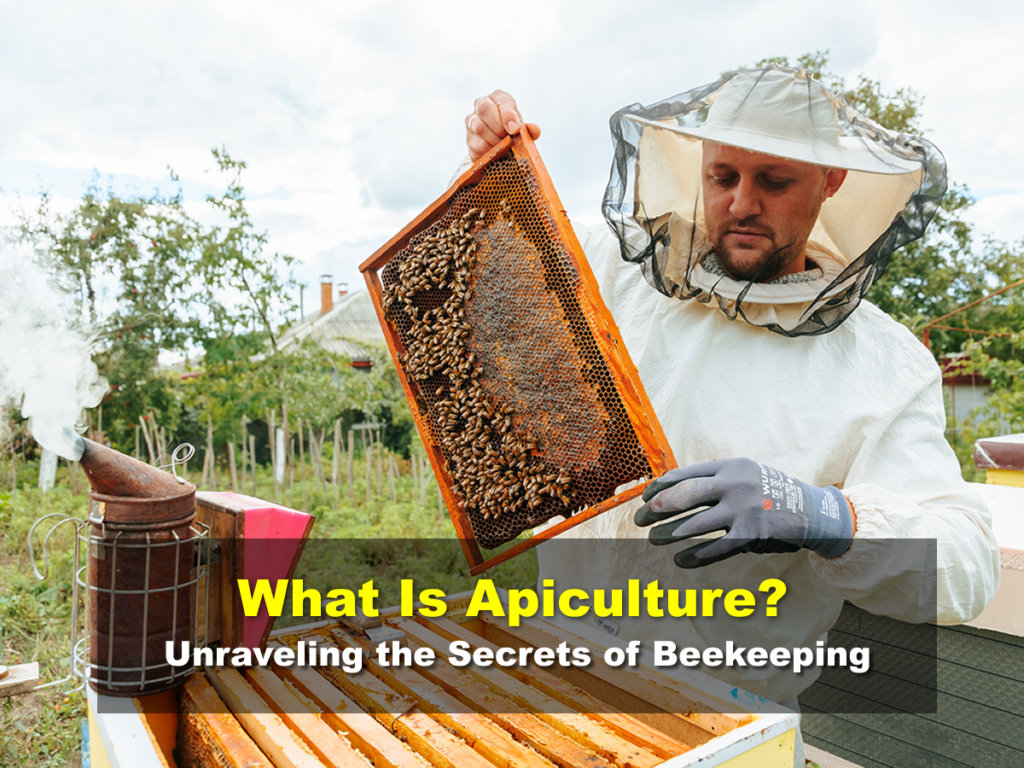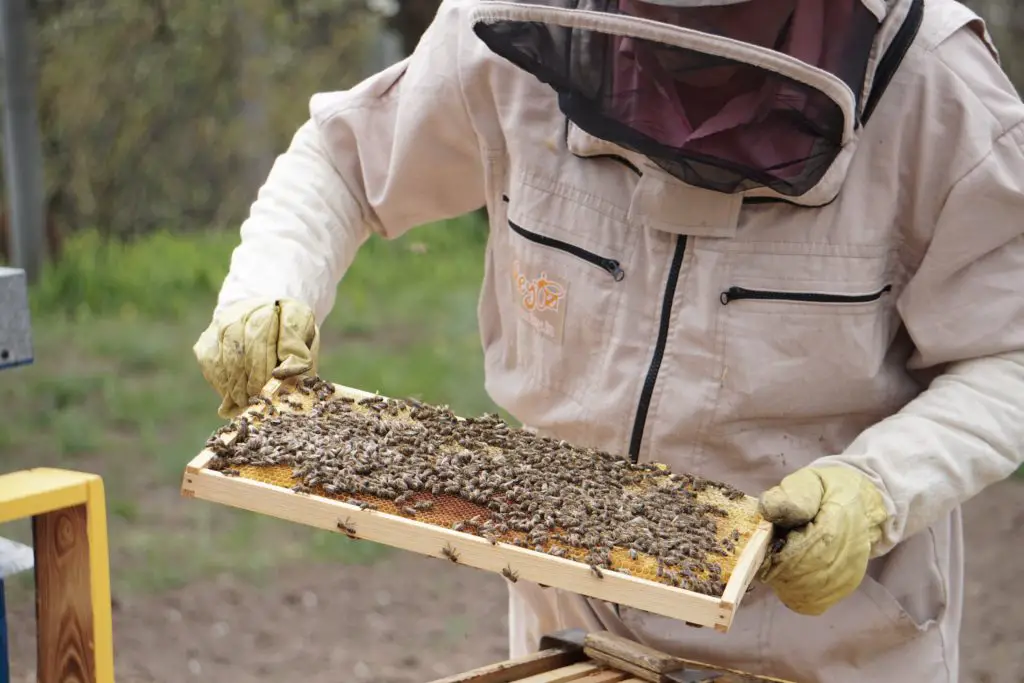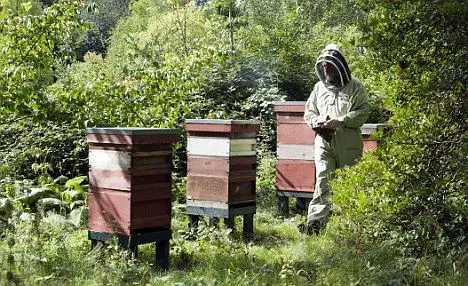Affiliate Disclaimer - As an Amazon Associate I earn from qualifying purchases.
It supports the website. So, Thank you
It seems as though there’s a technical term for everything and when you hear these terms, it can feel a little confusing. So what is apiculture?
Apiculture is the technical term used for beekeeping. According to one definition, it is the scientific rearing of honeybees and the word comes from the ancient Latin language and the word apis which means bees!
But whether you call it apiculture or beekeeping the fact that this is an important activity remains the same. Let’s take a deep dive into what apiculture is and why it’s so essential.
Table of Contents
An Introduction To Apiculture
There is a cave painting that was found in Spain that depicts a man in a tree taking honey from a bee nest. It’s thought that this painting could date back as far as 15,000 years. However, the general consensus is that apiculture, as we may recognise it today, began around 10,000 years ago. The guy in the Spanish cave painting was simply harvesting honey from wild bees which doesn’t exactly fit into our idea of beekeeping. That would be like saying taking milk from a wild cow made you a dairy farmer.
Even more recently, examples of modern beekeeping have been found in Ancient Egyptian painting and artifacts that date back around 5000 years. This is where we start to see apiculture taking place as a way for humans to raise bees and benefit from their honey production. For as far back in history as we can see, humans love the taste of honey. And while those in Ancient Egyptian societies loved taking care of bees, they certainly preferred wild honey and there were even teams of hunters that would go in search of it.
Not only did these people love to consume honey but they thought it was such a precious commodity that people would even be buried with it upon their death. Many archeological digs have discovered Egyptian tombs containing pots of honey and the best bit? It is still in perfect condition.
From Egypt, the notion of beekeeping soon spread further afield and it wasn’t long before the Romans and Greeks jumped on the apiculture bandwagon. But one thing that the Europeans did that was slightly bizarre to modern beekeepers was that they would kill the bees after each honey harvesting season was over.
From medieval times, right through to the 18th century, they would suffocate the bees using burning sulfur. Once the bees were dead, they would be removed from the hive and the humans could take all of the honey. Today, we know that a single colony can thrive for years so we now only take a small amount of honey and leave the rest for the bees to use as food over winter.
While people during this time would completely enclose the bees in hives made from terracotta, it wasn’t until the late 1700s that an English guy by the name of Thomas Wildman came up with a new idea for a hive. This model enabled humans to harvest honey without having to first break into the hive and therefore meant that the bees no longer needed to be killed. In fact, aside from a few differences, this initial version of the hive didn’t differ all that much to the ones we are accustomed to seeing today.
But then came the Langstroth hive which was invented by a man named Lorenzo Langstroth; hailed to be the Father of Beekeeping. These hives were so effective that they’re still one of the most common choices today and for saying they were initially created in the mid-1800s, that’s quite the inventive feat.
The Importance of Apiculture
One of the most obvious reasons that apiculture is important is that it is a great way to increase the local bee population. As you may well be aware, bees are at risk from things like habitat loss and environmental changes but as pollinators, they’re an essential member of our ecosystems. Apiculture ensures these populations do not dwindle to dangerous levels which would have a devastating effect on human crops; bees pollinate up to 75% of these!
Another reason that apiculture is so important is that it contributes to the unemployment problems seen in countries all over the world. And I’m not talking about commercial honey bee farms that hire people to work on them, I’m referring to individuals who set up small businesses producing honey and other bee products. While there’s no denying that a single hive isn’t going to make you a viable income, it’s certainly a start.
What’s more, apiculture gives humans access to two main products; honey and beeswax. While humans could almost certainly survive without these things, they definitely have their advantages.
Honey, for example, is an excellent source of food and it has been noted that as many as 80 chemical constituents within the product have significant food value for humans. Not only that but being a high-energy food, it’s essential for people who work in a labor trade as well as allowing the body to regain energy quickly.
On top of this, honey has many health benefits including those on the digestive system. For example, did you know that eating honey can reduce symptoms like excess gas and bloating? Moreover, it’s known for its ability to relieve constipation and it’s a totally natural method.
If you’re trying to lose or maintain a healthy weight then honey can be used to sweeten food and drinks instead of white sugar. It’s much lower in calories so there’s no need to have a bland diet in the name of staying trim.

If that wasn’t enough, we have to consider the medicinal value of honey which is known to be extremely beneficial to those with diabetes since it can support the effect of medication for this condition. Not only that but regularly consuming honey is said to reduce the chances of developing the disease in the first place.
For anyone with high cholesterol, honey is a viable natural ingredient to include in your diet. Not only does it lower cholesterol but it’s also renowned for its ability to reduce the risk of cardiovascular diseases. As a direct result of the advantages for the heart, circulation is improved which has been linked to improved brain function.
Not only this but it’s believed that raw honey could be an effective treatment for allergies, especially when eating locally-produced honey. It is also an antioxidant and antibacterial which is why so many people rely on it for the treatment of UTIs.
And it isn’t just in medicine and food that honey is important, we use it in a variety of cosmetic products too. It’s a popular ingredient in acne-fighting skin care products but it’s also incredibly hydrating so is often used in lotions. What’s more, honey is incredibly good for your scalp and hair which is why you’ll so frequently see it as an ingredient in shampoos and other hair care products.
Let’s also not forget about beeswax which also has a wide variety of advantages, making apiculture and the harvest of wax just as essential for humans. For example, wax is used to produce natural candles and in a range of cosmetic products thanks to its moisturizing properties. On top of this, beeswax is used in the manufacture of electrical insulators as well as in the pharmaceutical industry for the production of capsules.
Disadvantages of Apiculture
It would hardly be fair for me to talk about the importance and advantages of apiculture without touching upon the disadvantages. Of course, these downsides are certainly no reason to be deterred from starting beekeeping but they are food for thought for the new apiarist.
The first thing you need to consider is that, while bees are incredibly important, they do sting! Now, keeping a hive doesn’t mean that you’ll always be at the mercy of an angry swarm of bees. In reality, honey bees and most bee species, for that matter, are docile and gentle. They’ll only sting when they’re riled up but this can happen during hive maintenance and honey harvest.
Bees are very protective of their hive and they will literally put their lives on the line to protect it. You’ve probably heard that honey bees die after they sting and that’s because the stinger is ripped from their bodies leaving them with a fatal wound.
So, if you’re thinking about getting into apiculture I would advise you to invest in a bee smoker and some high-quality protective gear. It’s probably also worth checking whether you have an allergy to bee stings before you get started as some people respond very badly and a single sting could even cause death.
Another potential drawback to apiculture is that it isn’t a hobby (or business venture) for people that like to keep busy. Bees pretty much look after themselves and while there is a degree of work involved, it’s not an immersive pastime. In fact, aside from some general hive maintenance and twice-annual harvesting, you won’t need to do much at all. The benefit of this, however, is that you do get to spend a lot of time observing the bees and that, in my opinion, is a real treat!
Finally, you have to consider that apiculture isn’t always easy, especially in your first year. I can’t tell you the number of new beekeepers that have found their colony wiped out after the first winter and this can be incredibly disheartening. Just know that, if this happens to you, you’re not the first and you won’t be the last.
Winter is a tough time for even the most well-established colonies due to a lack of food and a drop in the temperature. That’s why it’s so important to make sure your hives are secured and protected for the winter and that you don’t overharvest the honey because the bees will use it for sustenance during the cold months. In some cases, where a colony is brand new, they may not produce enough honey to see them through and the beekeeper must supplement this with sugar syrup.
What’s more, bee colonies are highly susceptible to pests and diseases, most notably varroa mite. It’s quite easy for the colony to be killed off if the problem isn’t dealt with and oftentimes, when you notice disease, it’s already too late.
As long as you go into apiculture with an open mind to the possibility that you may have to start from scratch at least once then you won’t risk being disappointed.

Tips For Getting Started With Apiculture
If, after having read all of the information above, you feel as though apiculture is something you’d like to invest in then there are a few things I would urge you to consider first. Getting started certainly isn’t difficult but you need to make sure you have everything you need if you want the greatest chances of success.
Understanding Bees
Before you buy any equipment or any bees, the most important thing you can do as a new apiarist is to educate yourself. The more knowledge you can gain the better and that all starts with gaining a greater understanding of honey bees and what they’re all about.
When you raise a colony, you could end up with anywhere between 10,000 and 80,000 individual bees. Some of the largest colonies may have up to 100,000 members so that’s a lot of bees to take care of. The good news is that they typically thrive on their own and each member of the colony has its own role to play.
In any given colony, there is one queen and it is her responsibility to grow and sustain the colony by breeding. She alone lays all of the eggs and in her lifetime, she could lay as many as 800,000 eggs! She of course needs males to mate with and these are called drones. For all intents and purposes, drones are pretty lazy and don’t do anything other than attempt to mate with the queen. If they’re successful, they’ll pass on their genes and die shortly after. If they’re not, they’re usually shunned from the colony and death isn’t far behind as they struggle to survive on their own.
Once the eggs hatch, some of the larvae will be fed on royal jelly as they have the potential to become the new queen. However, most bees will either be drones or workers. Worker bees are always female and it’s their job to collect pollen and nectar, maintain the hive, and raise the young.
Types Of Honey Bees
One thing that you need to be clear about when starting out with apiculture is that there is more than one species of honey bee. Out of the 20,000 different bee species, around eight are honey bees and there are a further 43 subspecies of honey bee. That said, only four of these species are commonly used in apiculture, these are as follows.
- The rock bee (Apis dorsata) is a large species of honey bee and one of the most beneficial to beekeepers thanks to how much honey it produces. Each year, a single colony of rock bees could produce as much as 40 kg of honey!
- The next species is the Indian bee (Apis indica) which doesn’t produce anywhere near as much honey as the rock bee, at around a maximum of 5 kg a year. However, this species can be very easily domesticated so is a popular choice for new beekeepers.
- There is also the little bee (Apis florea) which again, does not produce a lot of honey. Its annual yield is typically no more than 1 kg. But the massive advantage of these bees is that they’re one of the most docile species that almost never stings so, for new beekeepers, it takes out some of the stress when harvesting honey or looking after the hive.
- Finally, we have the Italian bee (Apis mellifera) which is another species that rarely stings. They perform a delightful dance to alert other members of the colony to food and produce a good yield which is why this is one of the most popular species in apiculture.
Things You Need To Do
If you want to make sure that your apiculture journey is as fruitful as possible then planning is essential. Getting started doesn’t take a lot of work but there are some things you need to do.
- Start by purchasing your bees which can be done online or via a local supplier. Many new beekeepers make the mistake of waiting until spring comes around to order a packet of bees. However, by this time, most bees have already been sold so by getting in early, you can guarantee you’ll be able to make a start in spring. Usually, you’ll order the bees in January and collect them or have them delivered in April or May, depending on the local climate.
- If you’re unsure about where to buy bees or which bees are best for your area then there are tons of beekeeping associations. (I have a list by state here.) It’s well worth signing up for one of these as you’ll be able to get advice from experienced keepers and you may even be gifted equipment. What’s more, these associations have meet-ups and other events that can be extremely beneficial to your new hobby.
- Once you have ordered your bees, the next task is to choose a hive. You’ll generally pick between a hive system or a Langstroth hive. It really all comes down to personal choice but the general consensus is that the Langstroth hive is the best option for beginners.
- As well as your hive, you will also need to invest in some beekeeping equipment. This can include things like protective gear, hive tools and brushes, a bee smoker and many other things. Buying a beekeeping starter kit is usually the best option as it’s more affordable and comes with everything you need, often including books, information and courses on beekeeping.
- When it’s time to add your bees to the hive and everything is set up, you now have the task of taking care of your colony. As I have already mentioned, there’s not a lot to do but you will be able to find things to keep you busy such as checking in on the bees and performing any necessary hive maintenance.
Final Thoughts
Have you ever asked yourself what is apiculture? If you’ve been looking for a new hobby and have perused potential lists, it’s something that may have popped up. Quite simply, apiculture is a term for beekeeping and it’s something that’s not only hugely enjoyable but also beneficial to the local ecosystem.
Moreover, apiculture is a great way to supplement your income or even start your own honey production business. The great thing is that your colony, once established, will pretty much take care of itself.
If you’re a nature lover or wildlife fan then apiculture could well be the right pastime for you. There’s nothing more satisfying than watching your bees thrive.




